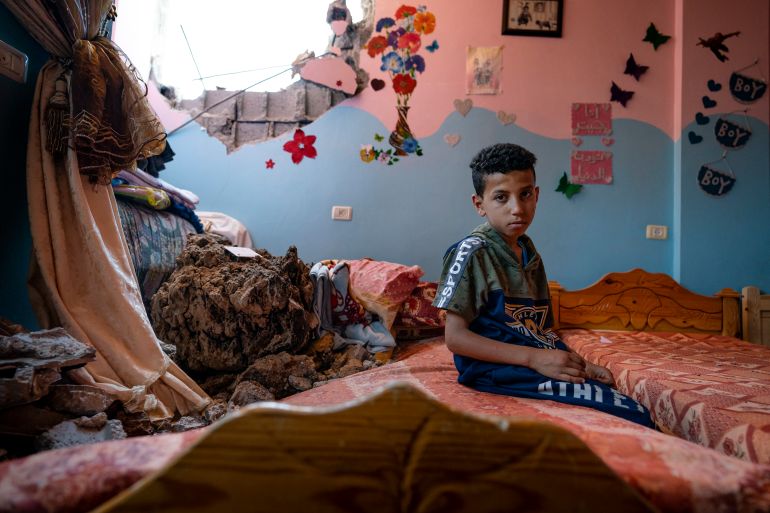Trauma and mental health in Gaza
Israeli occupation, bombs and oppression inflict not only physical but also psychological damage on Palestinians.

The May 20 ceasefire between the Israeli government and Hamas brought the latest round of conflict in the region to an end and led to a collective sigh of relief from the beleaguered Palestinians of the Gaza Strip.
But the deep wounds the violence opened remain fresh.
Keep reading
list of 4 itemsIn India’s richest state, exam scams kill escape from farm crisis
Displaced 12-year-old boy becomes Gaza’s youngest medic
Why are so many young Americans suffering from mental distress?
Eleven days of Israeli bombardment on the besieged enclave left 256 Palestinians, including 66 children, dead. Nearly 2,000 have been injured. Homes, offices and hospitals have been destroyed.
As the fragile ceasefire appears to hold, those who survived the conflict are once again trying to rebuild their lives. But the damage inflicted during those 11 days was not only physical and material. The mental health of Palestinians in Gaza was also bombarded during those dark days.
Living in fear of the next air attack, the spectre of death looming. Losing loved ones and homes. It is hard to imagine how utterly traumatising their reality has been.
Residents of Gaza have been enduring layer upon layer of trauma for decades. The deadly Israeli onslaughts are the most damaging – four in the last 14 years – but they occur against the background of chronic trauma imposed by the occupation.
Atrocities like the seizure and demolition of homes, oppressive policing, unlawful killings, detention without trial and torture all inflict profound psychological damage. Such perpetual subjugation can destroy self-esteem and leave victims in a state of “learned helplessness” – resigned to their fate and vulnerable to depression.
Israel’s illegal blockade on Gaza also amounts to a psychological stranglehold. The resulting economic deprivation has caused widespread unemployment and poverty – well-recognised risk factors for mental illness – and left health services underfunded, underdeveloped and unable to meet the demand. Each war on Gaza decimates them further – at least six hospitals, two clinics, a health centre and a Palestine Red Crescent Society facility sustained damage this time.
For most other countries, COVID-19 is currently the primary public and mental health concern. In Palestine, it is almost an afterthought, superseded by more dangerous assailants – air attacks and oppression. Nonetheless, more than 110,000 people in Gaza have been infected with the virus thus far, with more than 1,000 deaths. There are only enough doses available to vaccinate 60,200 people in a population of more than 2 million. So pandemic anxiety is also rampant in Gaza, adding to the mental burden.
All this turmoil translates to actual mental illness. In Gaza, rates of post-traumatic stress disorder (PTSD) which features disrupted sleep, feeling permanently on edge and easily startled, flashbacks and nightmares of the trauma and emotional numbing – are incredibly high. A 2017 study found 37 percent of the adults living on the Strip qualify for the diagnosis.
In my work as a psychiatrist, I have treated refugees with PTSD from the wars in Iraq and Afghanistan. It can be severe, complex and protracted. It would be almost impossible to start the healing while the root causes persist. The head of mental health services in Palestine once said her people do not suffer from post-traumatic stress disorder because their trauma is ongoing. Present-traumatic stress disorder may be a more fitting description of their experience.
As is often the case in these situations, children suffer the most in Palestine. A study conducted in 2020, before the latest conflict, found that 53.5 per cent of children in Gaza were suffering from PTSD. Nearly 90 percent had experienced personal trauma. The Norwegian Refugee Council reported the devastating news that 11 of the children killed by the recent Israeli air attacks were participating in its trauma programme. No wonder UN Secretary-General António Guterres described Gaza as “hell on earth” for children.
Of course, Israelis have suffered too. Twelve were killed by Hamas rockets in May, two of them children – a tragic loss of human life. But for the Israelis, the Iron Dome defence system and bomb shelters provide a vital safety net and sense of security that Palestinians live without. Their highly developed healthcare services are far better equipped to deal with both physical injuries and the psychological impact of rocket fire. They are not living through the mental anguish of occupation either. All this is reflected in their lower PTSD rates, ranging from 0.5 to 9 percent of the population.
Back in 2008, I went on a trip to post-conflict Somaliland to teach psychiatry to medical students. The civil war affecting the area ended in 1991 but its effects on the mental health of the population and health infrastructure were still evident some 17 years later. They still continue to this day. It will take time to rebuild the fragmented minds and health services in Gaza, but there is little hope for them until Israel ends its illegal occupation, settlement expansion and blockade on Gaza.
The oppression of Palestinians has led Human Rights Watch to the conclusion that Israel is committing the crime of apartheid. Perhaps viewing this situation through the prism of human rights violations and their grave impact on mental health might prompt the international community to pressure Israel to act. Palestinians and Israelis both deserve security and protection from trauma. The best way to achieve this is by affording Palestinians their basic human rights.
The views expressed in this article are the author’s own and do not necessarily reflect Al Jazeera’s editorial stance.
